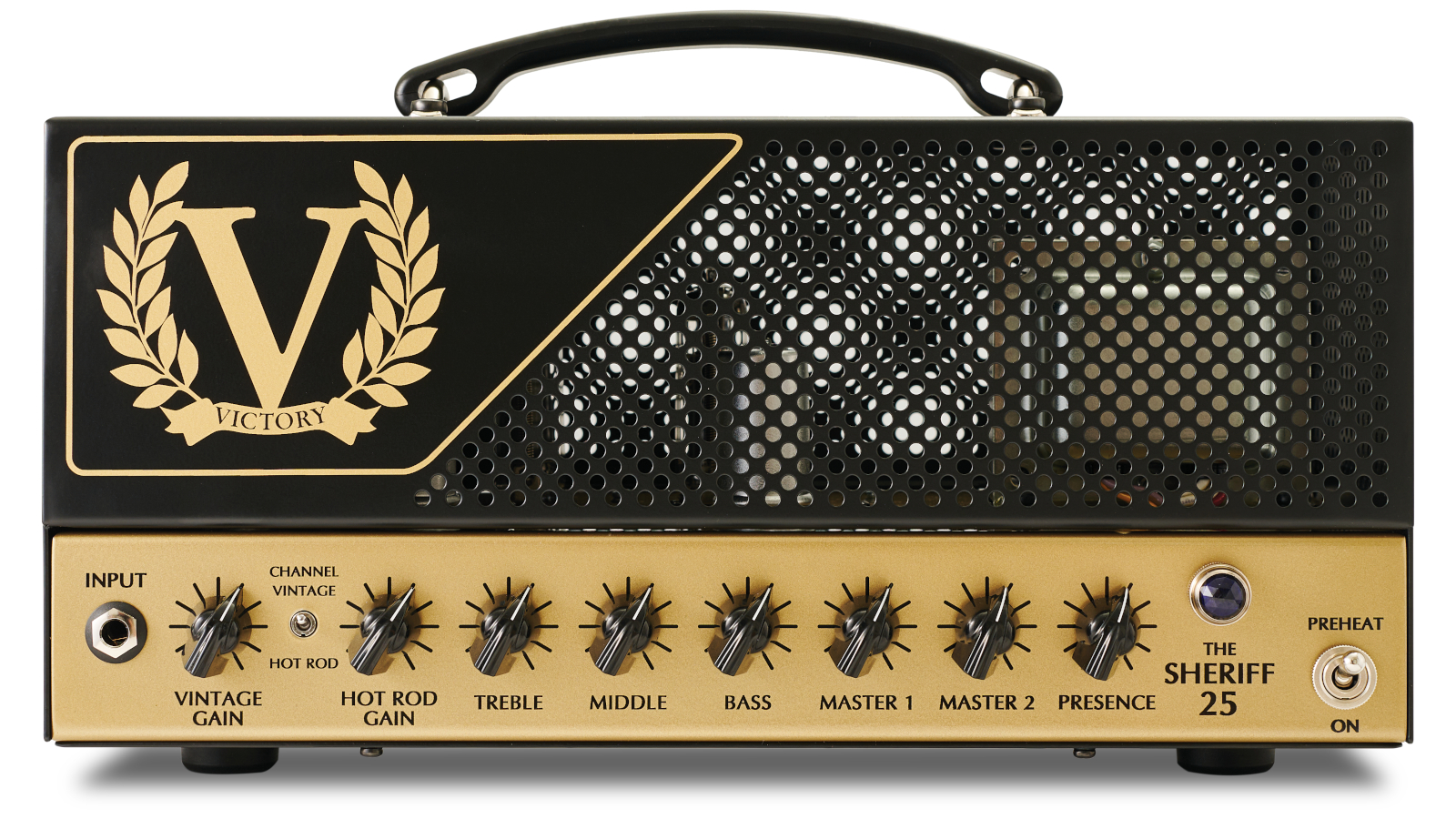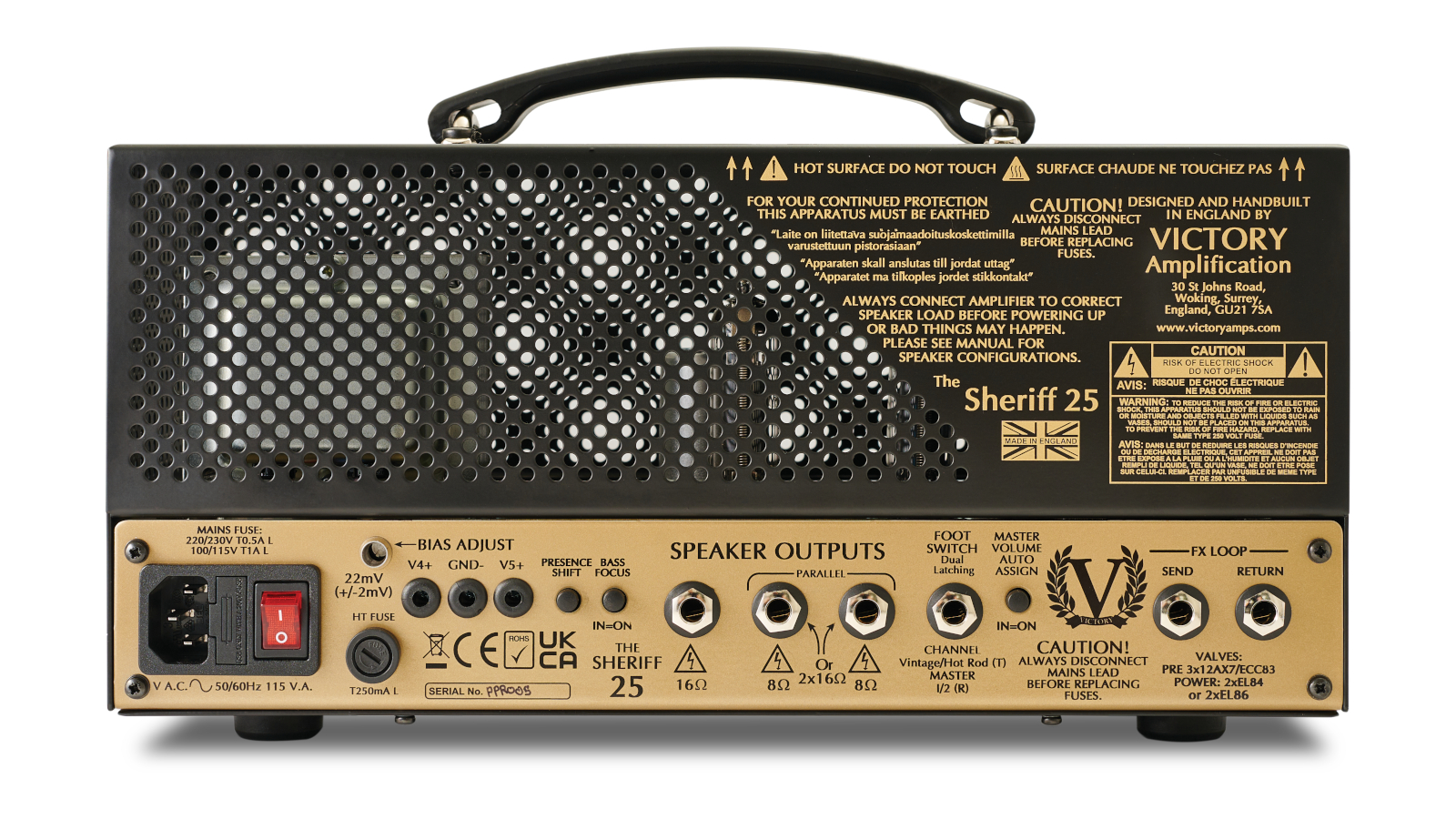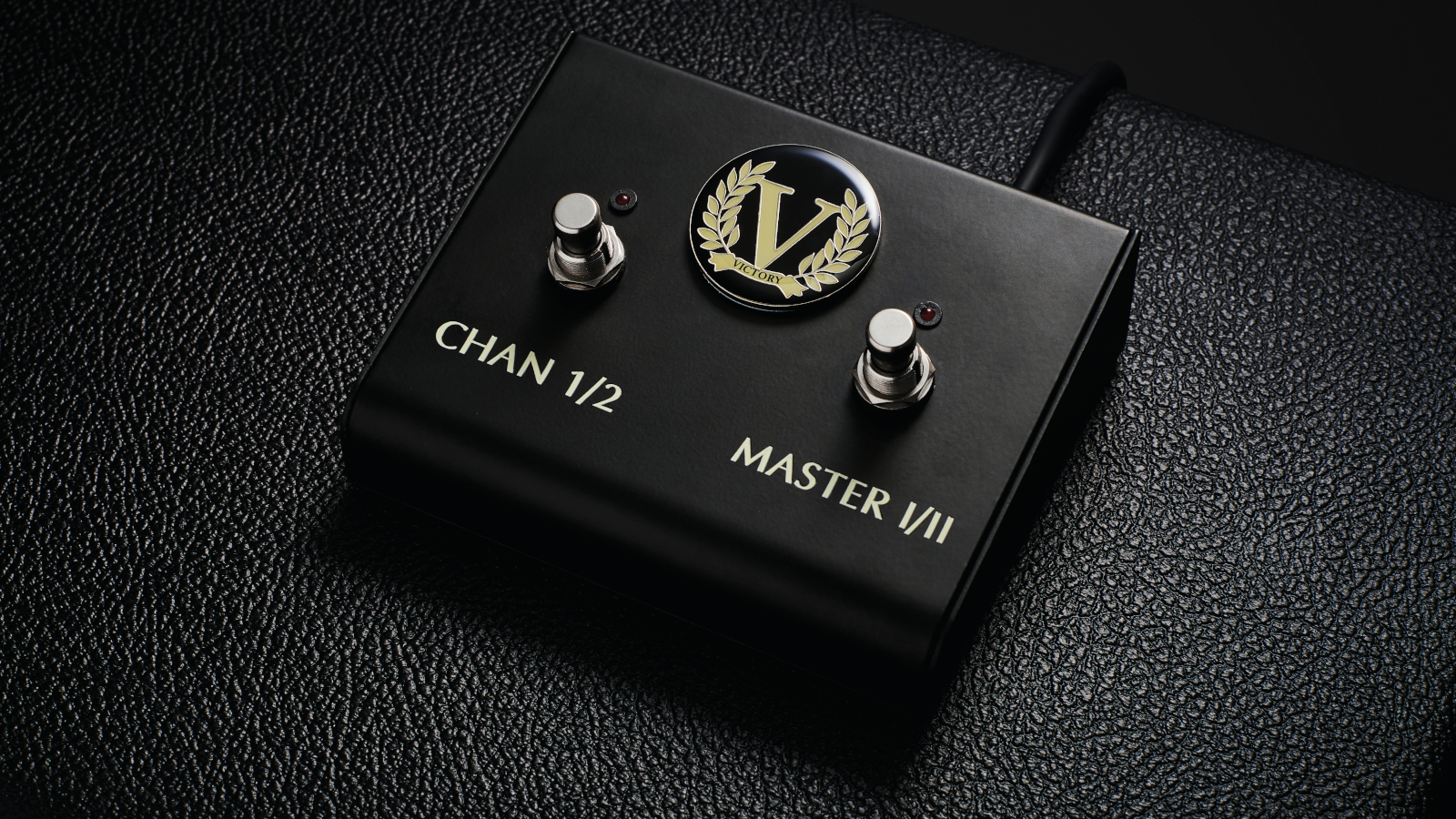GuitarPlayer Verdict
Occupies territory somewhere between the small 20-watt Friedman heads and the Mesa/Boogie Mark 5:25, but with its own voices and character
Pros
- +
A versatile and toneful little tube head that belies its compact size
Cons
- -
Some electronic hiss on higher gain settings
You can trust Guitar Player.
At his former gig, designing amps for the now-defunct Cornford Amplification, Victory head designer Martin Kidd helped produce some of the most highly regarded hand-wired creations in the history of British boutique guitar amplification. Since turning his talents to Victory for the past 10 years, he has delivered what is to my mind an “archetypal tube amp for our times” in the fully revamped Sheriff 25.
The two-channel, 25-watt Sheriff 25 is the smallest member of the newly redesigned Sheriff lineup, excluding the V4 pedal amplifier. It replaces the previous Sheriff 22 model and adds a bevy of handy new features to the template, as well as improvements in the tone department. Victory’s motto for the Sheriff series is “maximum sound with minimum fuss,” a sentiment very well expressed in this lunchbox-sized offering.
Measuring 14 by 6 ½ by 6 ½ inches, and weighing a mere 16 ½ pounds, the Sheriff 25 is nevertheless a full-size amp in every other regard. Those compact dimensions will be a big part of the amp’s appeal for many players today, and they allow it to come in a rugged and very handy gig bag, complete with shoulder strap and room for accessories. That said, guitarists who don’t need to save space or weight shouldn’t rule it out.
Following the single input, the amp’s front panel carries controls for Vintage gain (clean-ish) and Hot Rod gain (lead); shared controls for treble, middle and bass; controls for master 1 and master 2; and a shared presence control. There is also a toggle to switch between channels without the foot switch attached, and a front-mounted standby switch (labeled preheat/on).


Around back are the power switch, effects loop send and return, outputs for 16- and eight-ohm speaker loads, a Bass Focus push button that tightens up the lows, a Presence Shift push button that reduces negative feedback for livelier upper-frequency content, and bias check and adjustment points.
Here, too, is a TRS foot-switch jack and Master Volume Auto Assign. These latter two work hand in hand: Rather cleverly, the two master controls on the front can be automatically assigned to correspond to their respective channels, or selected on the second button of the foot switch (included) to access two overall volume levels from either channel, allowing rhythm and solo levels, for example.
Powering it all are three 12AX7s in the preamp and phase inverter and two EL86 output tubes in fixed bias. No, that’s not a typo. Although the more common EL84s can be substituted (re-biasing required), the amp ships with EL86s, which develop a few more watts of power and do so from slightly lower applied plate voltages. Cool!
All the latest guitar news, interviews, lessons, reviews, deals and more, direct to your inbox!
Where suitable, Victory uses hand-wired tag-board circuits for many of its amps, alongside printed circuit boards (PCBs) where they make the most sense. It’s no surprise that this lunchbox uses the latter entirely, given the challenge of fitting so much circuitry into a tiny enclosure. It’s a high-quality PCB, to be sure, and tube sockets are reinforced with chassis mountings. Transformers are made, by Demeter Windings of Chelmsford, England.



Tested with a Fender Telecaster and Gibson Les Paul, running through a closed-back 2x12 with Celestion Greenbacks and an open-back 1x12 with a Scumback J75, the Sheriff 25 immediately showed it has a lot to love, and I just as quickly forgot that the amp producing all that goodness was about the size of a loaf of pumpernickel.
Naming channel one the Vintage channel was a clever move, as it totally nails the vibe. Mostly clean with the Telecaster up to about 3 o’clock, and clean-ish with the Les Paul to a little before noon, it’s a trenchant, dynamic tone that presents a lot more character than the clean (read “boring”) channels on many lower-to-midpriced modern channel switchers, and for my tastes is a lot more usable as a result. Victory calls it a “vintage British” circuit, although it’s neither purely Voxy or Marshally and perhaps something in between, with a pinch of Fender thrown in. Regardless, it’s a good one and totally satisfies its intentions.
The Sheriff 25 immediately showed it has a lot to love, and I just as quickly forgot that the amp producing all that goodness was about the size of a loaf of pumpernickel
Having said that, it’s often the lead tones that sell you on amps like this, and when those are exciting enough, guitarists will tend to overlook underwhelming clean channels. Given that channel one is a home run, channel two should be the icing on the cake, and indeed it is. Dubbed the Hot Rod channel for good reason, to my ears it’s equal parts cranked 2204 and California high-gain, although the gain knob has an impressive range that goes from a slight edge of chewy grit to all-out flame-thrower. In short, this channel rips, and it easily covers just about anything you’d want on the spectrum from classic-rock to grunge to heavy/contemporary rock, short of thundering doom metal (though it chugs pretty well through the 2x12 with the Bass Focus setting engaged).
The “bonus functions” – the creative voicing buttons and extra bells and whistles – provide usable versatility, and the effects loop works just as it should. There was some electronic hiss on our review sample when I pushed the Hot Rod channel’s gain anywhere past 11 o’clock, and it increased slightly as I went up from there, even remaining rather noticeable with the master down pretty low. Possibly that’s the product of cramming so much into such a tight space. Start playing, though, and it disappears behind the maelstrom of rich, saturated lead tone.
All in all, this is a fantastic little beastie that occupies territory somewhere between the small 20-watt Friedman heads and the Mesa/Boogie Mark 5:25, but with its own voices and character. As a result, it’s a confident Editors’ Pick Award winner.
Specifications
- CHANNELS: 2
- CONTROLS: Vintage gain, Hot Rod gain, treble, middle, bass, master 1, master 2, presence
- POWER: 25 watts
- TUBES: Three 12AX7 preamp tubes, two EL86 output tubes
- EXTRAS: Two-button foot switch, FX loop, Bass Focus and Presence Shift switches, Master Auto Assign switch, bias check and adjustment points, 8 Ω and 16 Ω speaker outs
- WEIGHT: 16.5 lbs
- BUILT: England
Visit Victory Amps for more information.
Dave Hunter is a writer and consulting editor for Guitar Player magazine. His prolific output as author includes Fender 75 Years, The Guitar Amp Handbook, The British Amp Invasion, Ultimate Star Guitars, Guitar Effects Pedals, The Guitar Pickup Handbook, The Fender Telecaster and several other titles. Hunter is a former editor of The Guitar Magazine (UK), and a contributor to Vintage Guitar, Premier Guitar, The Connoisseur and other publications. A contributing essayist to the United States Library of Congress National Recording Preservation Board’s Permanent Archive, he lives in Kittery, ME, with his wife and their two children and fronts the bands A Different Engine and The Stereo Field.


